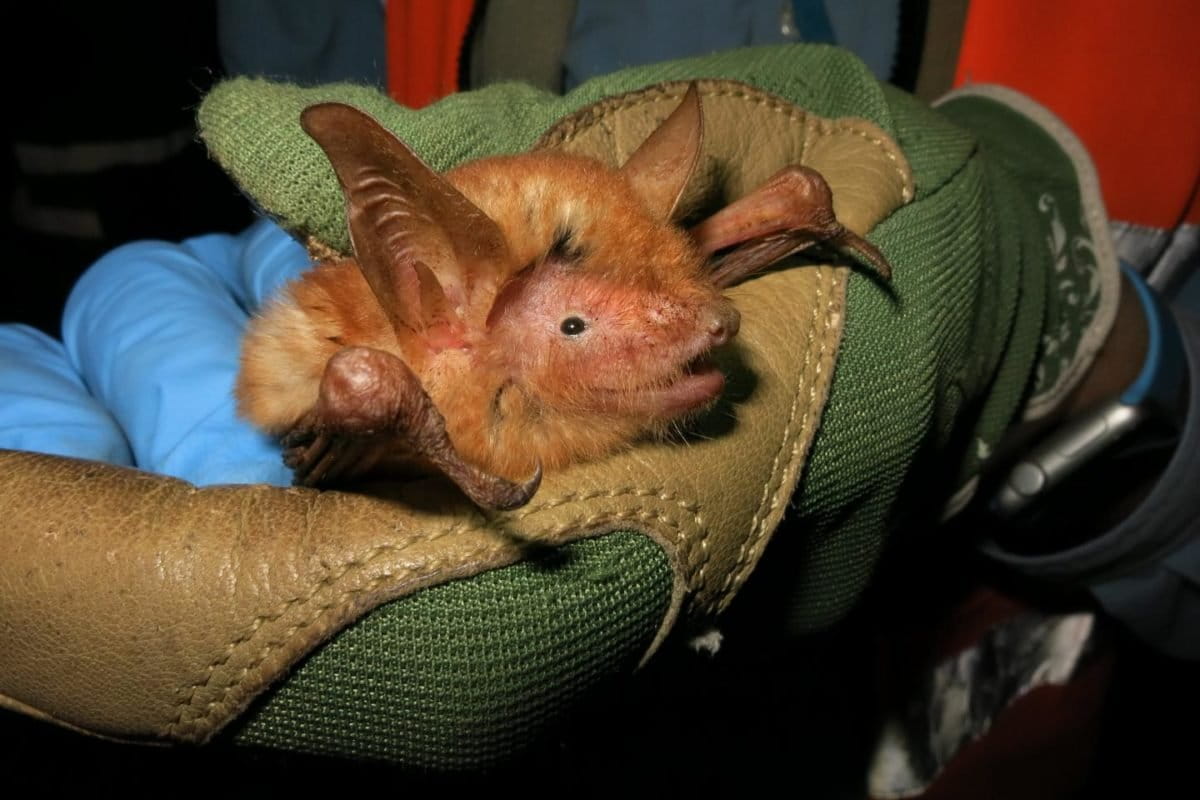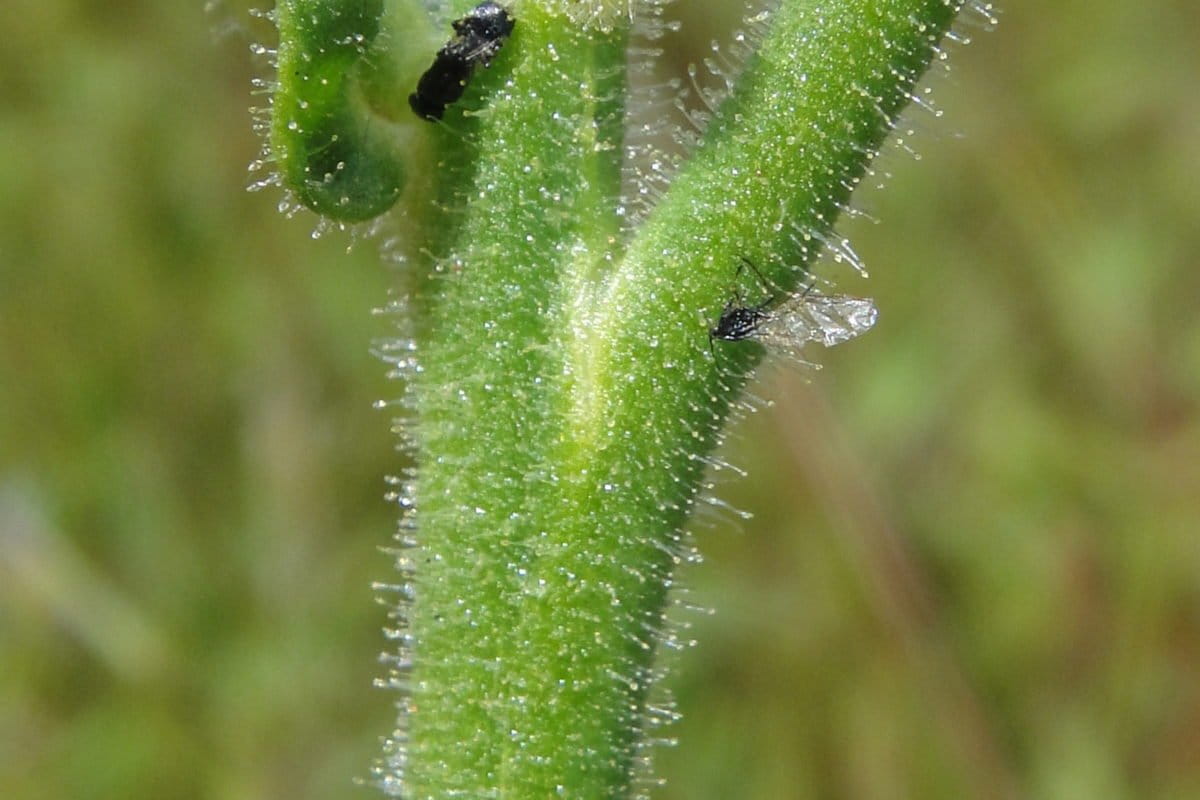
- Science has only just begun to find and describe all of the species on Earth; by some estimates, only 20% have been described.
- This year, Mongabay reported on newly described species from nearly every continent, including an Ecuadoran ant whose name broke the gender binary, an acrobatic North American skunk, an Australian “killer tobacco,” a fuzzy orange bat from West Africa, tiny screech owls from Brazil, and more.
- Though a species may be new to science, that doesn’t mean it has not yet been found and given a name by local and Indigenous communities.
With humans sending probes to explore Mars and the sun, one might think we’ve already explored the full extent of our own planet. But scientists say we’ve only begun to find and describe the riches here on Earth.
“I think most people believe that we know most species on Earth … but in the best-case scenario, we know 20% of Earth’s species,” Mario Moura, a professor at the Federal University of Paraíba in Brazil, told Mongabay in a March 2021 interview. Moura is a co-creator of a study that maps out places in the world likely to hold the highest number of species unknown to science. As it turns out, there are a lot.
This year, Mongabay reported on newly described species from nearly every continent, including a fuzzy orange bat from West Africa, tiny screech owls from Brazil, an acrobatic North American skunk, a snake from the Himalayas (found on Instagram), a new whale species in the Gulf of Mexico, an Ecuadoran ant whose name broke the gender binary, and an Australian “killer tobacco.”

“Every year, as scientists explore the world’s ecosystems, search herbaria and fungaria, sequence organisms’ DNA and, increasingly, browse social media, they come across species of plants and fungi that have not been scientifically described,” says the “State of the World’s Plants and Fungi 2020” report, released by the Royal Botanic Gardens, Kew.
However, though a species may be new to science, that doesn’t mean it has not yet been found by humans, or given a name.
“Many species that are new to science are already known and used by people in the region of origin — people who have been their primary custodians and often hold unparalleled local knowledge,” writes Alexandre Antonelli, director of science at RBG Kew.

A group of researchers found a fuzzy orange bat species in the caves and mining tunnels of the Nimba Mountains in Guinea, West Africa. The newly described species has been named Myotis nimbaensis, in honor of its home mountains, described as “African sky islands,” with peaks rising 1,600-1,750 meters, about a mile, above sea level. The bats are believed to be critically endangered. Bat Conservation International and local mining company Société des Mines de Fer de Guinée are working to reinforce the tunnels and caves so that the bats will have a safe home in the mountain.


Two new species of tiny screech owls have been described from the Amazon and Atlantic rainforests in Brazil. “They’re cute little owls, probably five or six inches long [13-15 centimeters], with tufts of feathers on their heads,” said John Bates, one of the researchers who described the new species. One of the new species, the Xingu screech owl (Megascops stangiae), was named in honor of the late Sister Dorothy Mae Stang, a U.S.-Brazilian land rights activist and Catholic nun who was murdered in 2005 by those opposed to her activism.
The owls are at risk of extinction and will likely be classified as critically endangered. The Alagoas screech owl has been found in only five isolated forest fragments in Brazil’s Atlantic Forest. Less than 10% of the Atlantic Forest remains, and only around 1% of this remaining forest is protected, despite having one of the highest degrees of species richness in the world.

A new orchid with white blossoms and a tall stem was found in the Guiana Highlands in Venezuela. The species is believed to live within an area of less than 20,000 square kilometers (7,700 square miles) and meets the criteria to be considered “vulnerable to extinction” under the IUCN Red List.
Members of the Pemón Arekuna Indigenous community of Paruima named the species in their native language. The researcher who described the new orchid, Mateusz Wrazidlo, advocates for “de-colonizing science nomenclature and giving more representation to Indigenous [and] local languages.”

Researchers have described 12 new gecko species from India’s Western Ghats mountains. One particularly stealthy gecko, described as “nearly impossible to catch,” was named after the famed actor and martial artist Jackie Chan.
The new species were found during four years of sampling in the Western Ghats, a chain of mountains running parallel to the western coast of the Indian peninsula. Most of the new geckos were found in caves or on the forest floor. They are quite small, most measuring only 3 to 4 centimeters (1.2 to 1.6 inches) in length.

Using genetic data and the body of a stranded whale, researchers determined that a group of whales in the Gulf of Mexico that looked like Bryde’s whales are actually a new species, which they named the Rice’s whale (Balaenoptera ricei). Scientists estimate that only 33 individuals remain alive and are threatened by marine ship traffic, plastic waste, and oil and gas exploration in the Gulf. The species is listed under the U.S. Endangered Species Act as critically endangered.

After careful examination of the features and DNA of a snake found in rice fields and streams in monsoon forests in China and northern Myanmar, scientists in China determined that the Suzhen’s krait (Bungarus suzhenae) was a new species The researchers chose to name the snake after Bai Su Zhen, a snake goddess from a popular traditional Chinese myth, the Legend of White Snake, “in honor of her courage to true love and kindness to people.”

The scientific tradition for naming new species in honor of a person has been to end the species name in “i” for males or “ae” for females. However, the scientists describing a new ant species from the Chocó region of Ecuador decided to break with this convention. The researchers used the pronoun “they” in the name to promote nonbinary gender inclusivity. The new ant, Strumigenys ayersthey, was named after the late human rights activist and artist Jeremy Ayers. Strumigenys have jaws that snap shut in what is one of the fastest movements known to be made by a living creature — 1.2 million meters per second squared.

After analyzing the DNA of a group of polka-dotted North American skunks (a cousin of the better-known striped skunk), researchers determined that rather than the four skunk species previously recognized, there are actually seven. Spotted skunks are sometimes called the “acrobats of the skunk world” due to their impressive handstands that give predators a warning that a noxious spray is coming. Although North American mammals are among the most studied animals in the world, scientists are still finding new species and learning things about their basic ecology.
About the size of an aspirin tablet, the newly described Brookesia nana chameleon from Madagascar is believed to be the smallest reptile on earth. Madagascar, though quite large, has a surprising number of miniature animals, many of them found nowhere else on the planet.
“We stumble upon new species on every expedition to Madagascar,” said Frank Glaw, who leads regular expeditions to Madagascar from the Bavarian State Collection of Zoology in Munich. Few of Madagascar’s original forests remain and they continue to be destroyed. “There is a kind of race against extinction. I would not be completely surprised if many of these species will be gone by the end of the century.”

More than 400 plant species were recorded during a plant-hummingbird study high up in the evergreen cloud forests of the Ecuadoran Andes, including three new-to-science orchid species. All three of the orchids are in the genus Lepanthes, an extremely diverse group that boasts an estimated 1,100 species. In three years of surveying, only 40 individual Lepanthes microprosartima plants were found, so the species has been preliminarily assessed as critically endangered according to IUCN Red List criteria.

A new chameleon species, named the Wolfgang Böhme’s Ethiopian chameleon, was found living in bushes and small trees in the Bale Mountains of south-central Ethiopia. The chameleon is around 15 centimeters (6 inches) long and has a distinctive crest of large spiny scales along its back and tail. The researchers suggest that the Ethiopian chameleon be considered a species complex, a group with an unknown number of species, rather than a single species, and they expect more species to be described from the group.
Many of Ethiopia’s endemic animals are found in the Bale Mountains, including the Ethiopian wolf (Canis simensis), leopards, warthogs, and many other endemic reptiles. Researchers say the biodiversity hotspot likely harbors many undiscovered species.

In 2015, a researcher navigated the steep and slippery terrain of the Peak Wilderness rainforest in Sri Lanka’s central highlands and found an unfamiliar plant in the Strobilanthes genus. Known as “sleeping beauties,” many of these plants flower only once every 12 years. So, year after year, the researcher returned to this difficult-to-reach place, waiting for the plant to flower. After five years, her efforts and patience finally paid off: this special Strobilanthes sleeping beauty’s flowers bloomed to reveal a new species, Strobilanthes medahinnensis.

In a lowland forest on the southwest coast of Java, Indonesia’s most populous island, a group of students participating in the Indonesian Herpetological Society’s citizen science program found five frogs sitting by a pond. It turned out they were a new-to-science species, a very small (around 2.5 centimeters or 1 inch) tree frog that can appear light yellow or light brown depending on the lighting. The frog’s “tik-tik-tik-tik-tik-tik” call is distinctive from any other known species. Chirixalus pantaiselatan is likely critically endangered. While there are more than 400 known frog species in Indonesia, only one is on the country’s list of protected species, and researcher say more attention to frogs is needed.


Researchers noticed an unfamiliar wild tobacco plant along a Western Australian highway. The tobacco, previously unknown to science, has been named Nicotiana insecticida, because its sticky hairs trap small insects. Because N. insecticida does not appear to be dissolving the insects for food, it isn’t considered carnivorous. The tobacco’s gooey glands, researchers believe, are simply there to protect the plant from being eaten.

During the COVID-19 lockdowns in India, a master’s student began taking pictures of the animals around his house, near the foothills of the Himalayas. A photo of a snake he posted on Instagram caught the eye of a herpetologist. After further investigations, they determined it was an unknown species belonging to a group commonly called kukri snakes, named for their teeth that are curved like a kukri, or Nepali dagger. The western Himalayas are comparatively less explored than many other regions, and researchers think there are more species to be found.
“It is quite interesting to note that how an image from Instagram led to the discovery of such a pretty snake that was unknown to the world,” herpetologist Zeeshan Mirza told Mongabay. “Exploration of your own backyard may yield species that are perhaps undocumented. Lately, people want to travel to remote biodiversity hotspots to find new or rare species, but if one looks at their own backyard, one may end up finding a new species right there.”
Banner image of new chameleon species, Trioceros wolfgangboehmei from Dinsho, Ethiopia. Photo by Petr Nečas from Koppetsch et al 2021. CC-BY 4.0.
Liz Kimbrough is a staff writer for Mongabay. Find her on Twitter @lizkimbrough
FEEDBACK: Use this form to send a message to the author of this post. If you want to post a public comment, you can do that at the bottom of the page.
Top 15 species discoveries from 2021 (Photos)
Source: Trends News

0 Comments